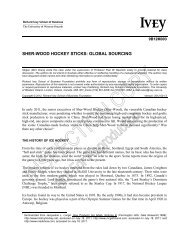foundation of canada asia pacific - Content Tagged with
foundation of canada asia pacific - Content Tagged with
foundation of canada asia pacific - Content Tagged with
You also want an ePaper? Increase the reach of your titles
YUMPU automatically turns print PDFs into web optimized ePapers that Google loves.
British Columbia provides a recent example <strong>of</strong> the results <strong>of</strong> following (or accepting)<br />
a strategy <strong>of</strong> more diversified economic relationships. BC has a trade pr<strong>of</strong>ile quite distinct<br />
from other Canadian provinces, <strong>with</strong> proportionately far more <strong>of</strong> its exports going to Asia<br />
than is the case <strong>with</strong> any other province and less to the US (except for Nova Scotia which<br />
trades heavily <strong>with</strong> Europe). During the North American recession <strong>of</strong> 1990-91, BC was<br />
the only Canadian province to maintain its economic momentum as the rest <strong>of</strong> the country<br />
followed the US slump. In the same way, when the Asian crisis hit in 1998, BC was the<br />
only Canadian province to slip into recession as the rest <strong>of</strong> the country rode the US boom.<br />
Canada will always have a closer relationship <strong>with</strong> the US than <strong>with</strong> Asia, but Asia can<br />
provide an insurance policy against over-dependence. Any further integration — for<br />
instance the adoption <strong>of</strong> a common currency — would only strengthen our marriage to<br />
the US business cycle. The prudent strategy for Canada is to diversify its ties to countries<br />
that do not necessarily follow the same business cycles as North America. (The irony is<br />
that the closer we become to another economy, the more we are influenced by its<br />
business cycle. The best strategy is to develop close economic ties <strong>with</strong> many countries.)<br />
49<br />
Canada’s automobile industry <strong>of</strong>fers a model <strong>of</strong> an area <strong>of</strong> production that is at potential<br />
risk because it has relied on the policy component <strong>of</strong> North American integration to develop<br />
a very limited range <strong>of</strong> markets or products. The top Canadian export to the world in<br />
1998 was motor vehicles <strong>with</strong> engine capacities in excess <strong>of</strong> 3,000 cc — mostly minivans<br />
and SUVs — accounting for 10.9% <strong>of</strong> all exports. More than 99.5% <strong>of</strong> these vehicles<br />
went to the US. If US consumers ever reduce their demand — because tastes change, or<br />
the stock market declines, or they simply become tired <strong>of</strong> getting eight kilometres to the<br />
litre as oil prices rise — both our export market and the economy <strong>of</strong> southern Ontario<br />
will be hard hit. The entire basis <strong>of</strong> this trade is the policy decision by the governments<br />
<strong>of</strong> Canada and the US to develop a transborder automobile industry. It is a prime argument<br />
for finding additional export markets to enhance economic security.<br />
PLAYING TO THE FUTURE<br />
The greatest flaw in Canada’s North American integration strategy may be that it looks<br />
to the past rather than the future. Today the US dominates the world economy,<br />
contributing an estimated 27.7% <strong>of</strong> global GDP. But time is on the side <strong>of</strong> Asia. In a detailed<br />
analysis <strong>of</strong> Asian growth (written just before the Asian crisis hit), the Asian Development<br />
Bank projected that Asia’s share <strong>of</strong> world income will rise from somewhere under 40%<br />
today to about 57% by 2025. 6 By that time, GDP per capita in East Asia (excluding China)<br />
will be virtually the same as that in the US. China’s GDP per person is projected to rise<br />
from the 10.8% <strong>of</strong> the US level it recorded in 1995 to 38.2% over the same period, while<br />
incomes in Southeast Asia will more than double relative to the US. 7 In other words,<br />
Asia will be catching up <strong>with</strong> the US — and the numbers <strong>of</strong> people involved means the<br />
size <strong>of</strong> the markets created will be far larger than those in North America. While few<br />
companies can afford to plan an investment strategy on a 25-year timeline, governments<br />
must. Our bureaucrats have a responsibility to develop policies today that our business<br />
people can exploit tomorrow.<br />
Increased ties <strong>with</strong> the US also may not provide the greatest benefits to the growth<br />
industries <strong>of</strong> the 21st century. Integration is generally considered in terms <strong>of</strong> increased



